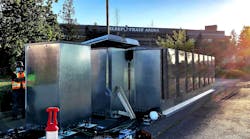Bloom’s Quick Build Microgrids Installed at COVID-19 Field Hospitals in California
Bloom Energy recently installed rapid deployment microgrids at two field hospitals in California in response to COVID-19.
The microgrids, which use Bloom’s fuel cell technology, were installed in less than a week at the site of a national hospital system in Vallejo and at a Sleep Train Arena in Sacramento.
Both sites have pop-up style field hospitals — the kind appearing in parking lots, convention centers and other usable spaces to accommodate hospital overflow from COVID-19.
See related article: Healthcare & Critical Service Microgrids in an Era of COVID-19
The new Vallejo microgrid serves a field hospital in the main hospital’s parking lot. The main hospital already uses 1,200 kW of Bloom fuel cells. With the installation of the microgrid for the field hospital, the facility added 400 kW more. Bloom installed the microgrid in three days in a compact spot, the equivalent of three parking spaces.
The Sleep Train Arena microgrid, a 400-kW fuel cell project, came about as a result of a request from the state of California, the second in recent months the state made to Bloom. The first occurred when Governor Gavin Newsom asked Bloom engineers to help refurbish ventilators.
“We partnered with Bloom Energy to quickly provide an on-site, reliable power solution and back-up capabilities,” said Ryan Buras, California Governor’s Office of Emergency Services deputy director.
Former home of the Sacramento Kings basketball team, the Sleep Train Arena is being reconfigured for 100 hospital beds. The microgrid was installed in under a week.
Bloom said that it continues to work with the state and other essential businesses to explore additional opportunities for rapid deployment microgrids during the pandemic.
The microgrids are offering the state more than a quick injection of reliable energy; they also offer a way to do so without increasing emissions — an important consideration in light of a link Bloom highlights between air quality and severity of COVID-19 symptoms.
In a blog posted yesterday, Bloom cites a Harvard study that finds even a small elevation in fine particulate matter can significantly increase the death rate from COVID-19. This makes operating diesel generators — a common backup source for hospitals — unwise near patients, according to the company. Unlike diesel generators, Bloom’s fuel cells use no combustion — a source of particulate matter emissions — but instead produce electricity through electrochemical reaction.
“Bloom’s microgrid solution dramatically reduces electricity costs and greenhouse gas emissions, which fulfills our commitment to providing clean and affordable energy during this pandemic,” said California’s Buras.
The company developed the rapid deployment microgrids as a result of California’s wildfires, which last year led to widespread power outages when utilities shut off power to customers to prevent transmission lines from sparking fires.
Learn more about healthcare microgrids at the free Microgrid Knowledge Virtual Conference, which will include a special session at 2 pm, June 1: Healthcare & Microgrids: Ensuring Power When the Value of Resiliency is Immeasurable







